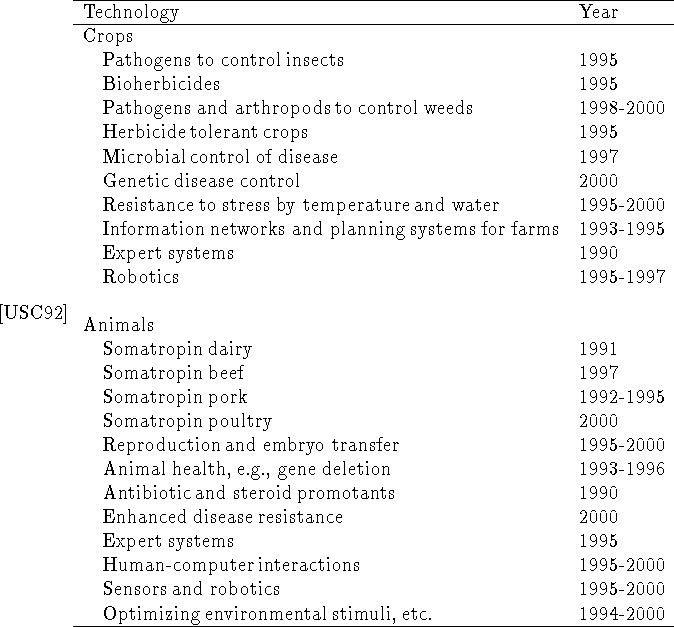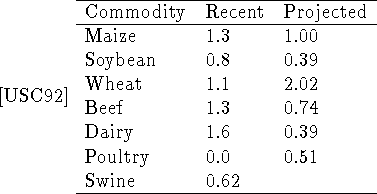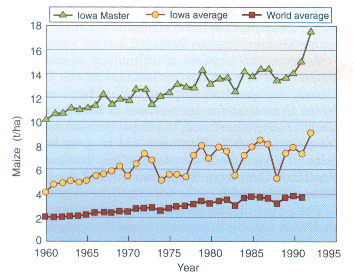The logistic curve in Figure 7.3.2 extending past improvements in yield toward 21 t/ha could mislead humanity into thinking an unseen hand lifts yields effortlessly. In fact, vigorous research and enterprising farmers do the lifting. Looking backwards, one can see how hybrid maize, pest control, and fertilizer raised yields. But looking forward, one worries whether a deus ex machina again will rush on stage.
Remembering the lag of decades between discovery and their impact on world averages, one asks whether any techniques are on the shelf to raise yields soon. ``Unfortunately, there are no identifiable technologies waiting in the wings that will lead to the quantum jumps in world food output. ...For the world's more advanced farmers, there are not many new technologies to draw upon. ...In some farming communities crop yields on the best farms now approach those on experimental plots." (Brown, 1988,[Bro88] 35; 37; 49)
Although a new genetics called biological engineering
dominates thoughts of new technology for agriculture,
a score of years after the subject first was
bruited, people no longer expect nitrogen-fixing maize
or other such miracles. An assessment of biotechnology
for the United Nations (Weiss and Brayman,
1992[WB92], 1-7)![]() conservatively foresaw that the early applications
to crops would be diagnostic tests, mapping
of genes, resistance to virus, and biocontrol of pests.
The assessment foresaw a timetable of applications:
1990-1993 herbicide tolerance; 1993-1996 processing
improvements; 1996-1999 industrial pharmaceutical
production; 1999-2003 environmental tolerance;
2003-2006 direct yield enhancements. So despite lowered
expectations, even biological engineering such
as bioherbicides
seem at hand. A range of other new
technologies able to increase yields per plot of land
or per volume of water lies closer to hand.
conservatively foresaw that the early applications
to crops would be diagnostic tests, mapping
of genes, resistance to virus, and biocontrol of pests.
The assessment foresaw a timetable of applications:
1990-1993 herbicide tolerance; 1993-1996 processing
improvements; 1996-1999 industrial pharmaceutical
production; 1999-2003 environmental tolerance;
2003-2006 direct yield enhancements. So despite lowered
expectations, even biological engineering such
as bioherbicides
seem at hand. A range of other new
technologies able to increase yields per plot of land
or per volume of water lies closer to hand.
Recently, a congressional office listed new technology for U.S. agriculture (U.S. Congress, 1992[USC92], 133-138) (Table 8.2.1). Rather than depending on the literature of, say, biology alone, the study employed panels of diverse minds: scientists, engineers, economists, extension and commodity specialists, representatives of agribusinesses and public interest groups, and experienced farmers. After studying scientific papers, the panels used the Delphi technique to reach a collective judgment about commercial introduction, yield increases, and adoption rates. I shall consider their central or most likely scenario and concentrate on on-the-shelf technology, that is, technology that the panels believed would be introduced by 2000 AD.

Table 12.1: Timing of commercial introduction of techniques
(U.S. Congress, 1992,133-138)
Many techniques on the list will protect rather than raise the ceiling on crop yields. Others will substitute new pest controls for synthetic chemicals. Precisely how expert systems, robots, and human computer interactions will raise yields remains unclear. On the other hand, several of the techniques for animals surely will get more meat, eggs, or milk from the same feed. The protection of yield will move average yields nearer ideal ones. And without understanding exactly how, one instinctively believes that genetic engineering will help plant breeding continue lifting yields. The paradox of yields rising in one species of crop and not in another seems an opportunity for the new art of moving genes between species.
Remembering that techniques are not instantaneously and completely adopted, the panels projected the impacts of techniques from 1990 to 2000 AD. I copied their most likely annual rates of change for crops and animals and added the recent changes for comparison (Table 8.2.2). I estimated changes from 1976 to 1989 by the trend in logarithms of national yield per plot and feed per product. By projecting annual improvements both faster and slower than actually occurred, the panels showed they had neither a pessimistic nor an optimistic bias.
The changes for dairy in Table 8.2.2 sustain my
view that the projections are rational. The technology
of bovine growth hormone has excited worries
about both the bankruptcy of farmers drowning in a
lake of milk and the health of drinkers of milk. A calm
reviewer (Ruttan, 1991[Rut91])![]() ,
however, can be found:
,
however, can be found:
From an economic perspective, the introduction of (the hormone) is unlikely to be any more significant than several other technical changes that have occurred in the dairy industry over the last several decades. When cast in the historical context of growth in output per cow, from just a bit over 5000 pounds per year in 1950 to approximately 14,000 pounds per year in 1990, (the hormone) seems more like an incremental rather than a revolutionary change.
If a panel were impressionable, their projections of dairy production would be erratic. The panel reassures me about their restraint and good sense, therefore, by projecting that technology will raise dairy productivity less during coming years than during recent ones.
Because the panel suffered from a concentration on biotechnology and computers, they overlooked several things waiting on the shelf. Notably, they generally overlooked engineering's potential to produce more crop per volume of water and to drain away excess water more economically. Happily, their oversight means that the list of things on the shelf is longer, not shorter, than in Table 8.2.1.
Because the impacts of technology projected in Table 8.2.2 are for the agriculture of the United States, the speed of adoption should be somewhat faster than that for agriculture in less developed lands. On the other hand, the impacts measured from the present to full adoption would be greater when measured from the lower yields of less developed agricultures than from the higher ones of the United States (Table 8.2.2.).

Table 12.2: Projected annual U.S. percentage rates of
improvement
during 1990-2000 for the most likely
technology (U.S. Congress, 1992, 133-138). For
comparison, the rates of improvement from 1976
to 1989 of yields per plot and feed per product
were estimated by regression of logarithms on
year
The panel identified technologies waiting on the shelf that are able to increase world food output, even by advanced farmers. For the less developed, the technologies, of course, have more potential.
A realist wants more than Delphic assurance. In reality, are average crop yields closing in on yields on the best farms, proving that farmers are using up the techniques on the shelf? Earlier I wrote of the American champion in Pasco, Washington who grew over 21 t/ha of maize, and I used his yield as a ceiling in Figure 7.3.2. By exceeding twice the national average yield of the United States, the 21 t/ha shows champions well ahead of averages.
The single 21 t/ha may not, however, convince pessimists that the gap between average and champion is not closing. But Figure 8.2.1 should (Food and Agriculture Organization of the United Nations, various years; Iowa Crop Improvement Association, 1993[Ass93a], pers. com.; U.S. Department of Agriculture, various years[USDa]). It displays the trend since 1960 of maize yields grown by the winners of the Iowa Master Corn Grower's Contest and also the trends of average yields by both Iowa and world farmers. The ceiling of 7.5 t/ha, plausible a score of years ago, is now forgotten (Thompson, 1975[Tho75]). The annual gains of about 2.2% by world and 1.7% by Iowa averages do exceed the 1.2% of the Iowa Masters. Absolutely, however, the Masters gained 0.14 t/ha annually, more than the 0.10 t/ha gain of the Iowa average and more than double the 0.06 gain of the world average. A larger divisor, not a smaller gain, lowered the Master's percentage. The winners' of the Iowa Master Soybean Growers' Contest also steadily stay ahead of the Iowa average soybean yields. New York farmers averaged 3.3 t wheat/ha in 1990-1991 although in 1978 an expert foresaw they would not produce a ten-year average of 3.4 until 2020 (Jensen, 1978[Jen78]). The reality of winners staying steadily ahead of averages confirms the oracles of technology assessment: Technology remains on the shelf for American farmers.
 Figure 8.2.1. The trends since 1960 of maize
yields grown by the
winners of the Iowa Master Corn Growers' Contest
and also of average yields of Iowa and world
farmers. The rising trend per year of yields for Iowa
Masters is 1.1% or 0.14 t/ha, for Iowa average is 1.7%
or 0.10 t/ha, and for world average is 2.2% or 0.06 t/ha
(Food and Agriculture Organization of the United
Nations, various years; Iowa Crop Improvement
Association, 1993, pers. com.; U.S. Department of
Agriculture, various years). [FotUN][Ass93a][USDa]
Figure 8.2.1. The trends since 1960 of maize
yields grown by the
winners of the Iowa Master Corn Growers' Contest
and also of average yields of Iowa and world
farmers. The rising trend per year of yields for Iowa
Masters is 1.1% or 0.14 t/ha, for Iowa average is 1.7%
or 0.10 t/ha, and for world average is 2.2% or 0.06 t/ha
(Food and Agriculture Organization of the United
Nations, various years; Iowa Crop Improvement
Association, 1993, pers. com.; U.S. Department of
Agriculture, various years). [FotUN][Ass93a][USDa]
A skeptic about technology may repair to developing nations, expecting no suitable technology to remain on the shelf for their farmers. A survey of irrigated Pakistani farms, however, shows a yield gap between masters and the average farmer. Ahmad's (1987[Ahm87], 23-27) tabulation of yields of major crops showed that progressive Pakistanis grow about three-fold the average yields. Technology likely remains on the shelf for farmers everywhere.
Because use lags discovery by decades, the inventory
on the shelf cannot be filled on need but must be
replenished continually. Between 1961-1965 and
1981-1985, the agricultural research personnel employed
in less developed countries increased 7% but
in more developed countries it only increased 2% per
year. The corresponding increases in expenditures in
constant dollars was 6 and 4% (Anderson et al., forthcoming[APRng]).
The expenditures by the Consultative Group
on International Agricultural Research provide an
index of effort to refresh the inventory, worldwide.
Unfortunately expenditures, which are of the order
of one-quarter billion dollars, have fallen steadily
since their peak in 1989 and in 1994 will stand 21%
below the peak.![]() So while the shelf holds technology
now, what it will hold in a few decades does worry
justifiably.
So while the shelf holds technology
now, what it will hold in a few decades does worry
justifiably.
A concentration on research should not cause the reader to think of technology as a single object. In fact, effectiveness requires a comprehensive system. For example, before it can deliver goods, the internal combustion engine must be set in networks of highways, filling stations, competent mechanics, and skillful drivers. Just so, an object like a gene, pesticide, or sprinkler invented by agricultural research only becomes effective when set in networks of breeders and seed companies, scouts and suppliers, or pumps and canals. It only becomes effective when farmers have the knowledge and information to use it, the money to buy it, and the facilities to harvest store, and transport the abundance it yields. It only becomes effective when profitable.